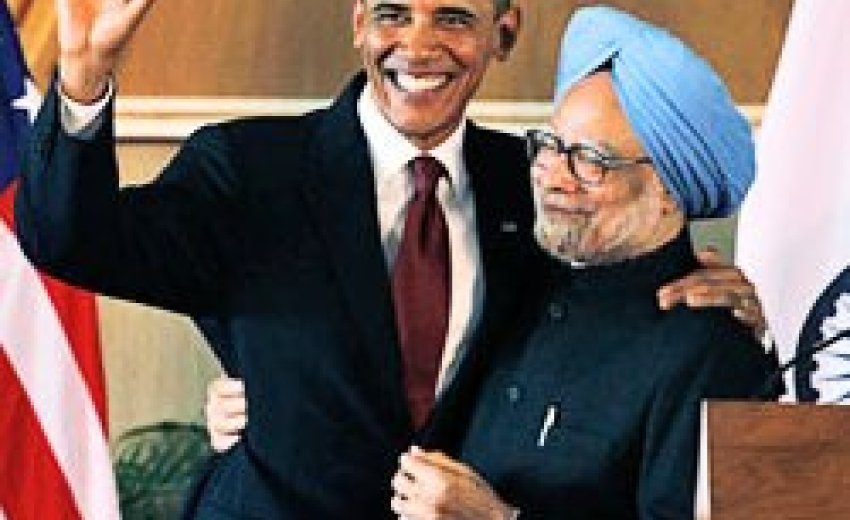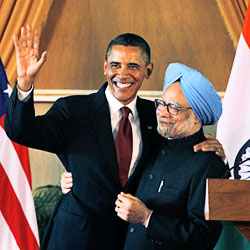While the exact reasons for his snub remain hazy, I believe he missed a golden opportunity to experience first-hand a spiritual tradition that has an awful lot to offer America and the world at large. Take for example my top three Sikh ideals (think life, liberty and the pursuit of happiness):
I’m talking about the Golden Temple’s free kitchen, which produces millions of nourishing meals every year to anyone in need of food—and being funded by donations, it’s completely free at the point of access and costs the state nothing. Now that’s a great expression of American philanthropy if ever there was one. Whatever the reasons for the presidential cold-shoulder, they should not overshadow the experiences of other American citizens who have left us their impressions of the Golden Temple. In fact, if only all the president’s men knew what the team behind ‘The Golden Temple of Amritsar: Reflections of the Past (1808-1959)‘ knew, things may have turned out differently.
|
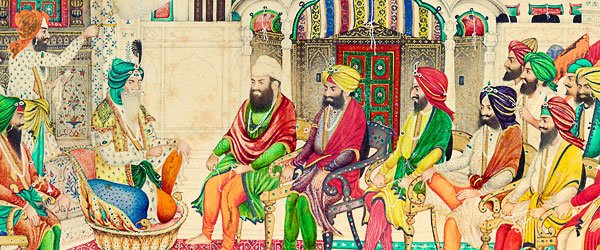 |
| The darbar of Maharaja Ranjit Singh. From a painting by Bishan Singh, c. 1860. Toor Collection. |
Napoleon’s victories in Europe gave rise to fears of a French invasion of India through Afghanistan, persuading the British to push for a more substantial alliance with the Sikh king.
In 1809, Ranjit Singh’s threats towards neighbouring Sikh chiefs led them to seek shelter from the British. Ochterlony’s military intervention was instrumental in bringing about the Treaty of Amritsar, which sealed Ranjit Singh’s southern border. While the Bostonian soldier-administrator went on to become agent to the governor-general at the Ludhiana Political Agency, the Sikh king pursued his conquests to the north-west unhampered.
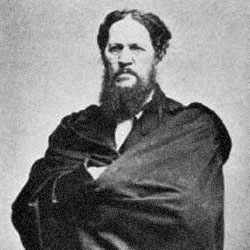 |
| The man who would be king: the only known photograph of Josiah Harlan. |
Like Alexander the Great before him, Ranjit Singh’s insatiable appetite for conquest gave rise to a prolonged campaign against the Afghans.
He embarked on a programme to modernise his army and offered civil and military posts to talented American adventurers like Josiah Harlan (1799-1871), an ambitious Quaker from Pennsylvania who was granted several governorships in the Sikh Empire in the 1830s.
Larger than life, Harlan’s later kingly exploits in neighbouring Afghanistan are thought to have inspired Kipling’s short story ‘The Man Who Would Be King’.
Another Yankee on the Sikh payroll was Alexander Haughton Gardner (died 1877). Following Ranjit Singh’s death in 1839, this American of Irish descent was an active participant in the events that led to the downfall of the Sikh Empire and the onset of a brutal civil war.
Gardner’s published memoirs record in graphic detail the instability and political intrigue that led to two wars between the Sikhs and the British for control of Punjab. Two narrow victories fell to the British, giving them the mandate to annex Punjab to their Indian territories in 1849.
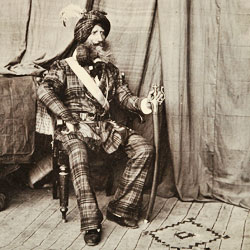 |
| Kashmiri commander in Tartan: Alexander Gardner ‘going native’ à la Sikh. Photograph by Bourne & Shepherd, 1864. Private collection. |
Gardner took no part in the fighting, preferring instead to serve as a spy for the British. Afterwards, he found gainful employment in Kashmir, recently sold by the British to a scheming courtier at the court of Lahore. Gardner was famously photographed in the 1860s wearing a native cut tartan uniform complete with turban à la Sikh crowned with plumes to match his fine array of whiskers.
If any of these remarkable Americans ever visited the Golden Temple, it’s a shame that they never wrote about it. The honour of being the first American to document his experience goes to a lawyer and wealthy real estate owner from New York who visited Amritsar just a few years after the Union Jack was unfurled over the fort of Lahore.
‘Mecca of the Sikhs’
John Busteed Ireland (1823-1913) spent two years in India during a six-year tour of the world, covering Europe, Africa and Asia, that began in 1851.
Like other travellers of his day, Ireland made hasty notes and sketches on the spot in a continuous journal of his wanderings. These were used to write letters ‘in the palanquin, on my lap, bed, or floor, and often oppressed by heat, cold, or travel’ to his mother back home.
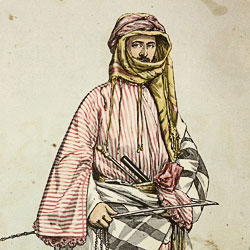 |
| John Busteed Ireland in Arab dress, c. 1851. Private collection. |
After a stopover in London to see the opening of the Great Exhibition (at which was displayed the famed, though considerably reduced, Koh-i-noor diamond, taken as booty from the defeated Sikhs), he eventually arrived in India in early 1853.
Ireland spent the next ten months soaking up sights at Bombay, Seringapatamand Calcutta, so he held high expectations of the Sikhs’ spiritual capital when he reached there in the winter of 1853.
His initial impressions of the walled city of Amritsar were favourable. ‘The streets’, he jotted, ‘are mostly paved with brick, and some are quite wide. The fronts of the houses display considerable taste.’
Having made a circuit of the principal bazaars and the famed shawl manufacturers, he soon reached the entrance ‘to the great tank, the Mecca of the Sikhs’.
To Be Continued…
Learn More
Article inspired by our new book ‘The Golden Temple of Amritsar: Reflections of the Past (1808-1959)‘.
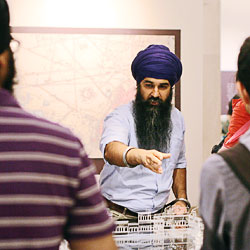 |
| Curator Parmjit Singh giving a guided tour at the Golden Temple exhibition, Brunei Gallery, SOAS, 2011. Photo: Verinder Singh. |
About the Author
Parmjit Singh is the author of several books on Sikh history including ‘Warrior Saints: Three Centuries of the Sikh Military Tradition’, ‘“Sicques, Tigers, or Thieves”: Eyewitness Accounts of the Sikhs (1606-1809)‘ and ‘In The Master’s Presence: The Sikhs of Hazoor Sahib’.
He is currently working on a special edition of ‘Warrior Saints’, due to be published in 2012.
He is also a founding director of Kashi House, a not-for-profit social enterprise that produces illuminating resources on the culture and heritage of Punjab and the Sikhs.
